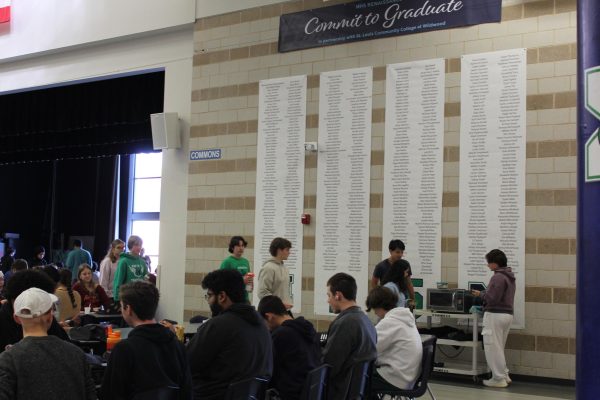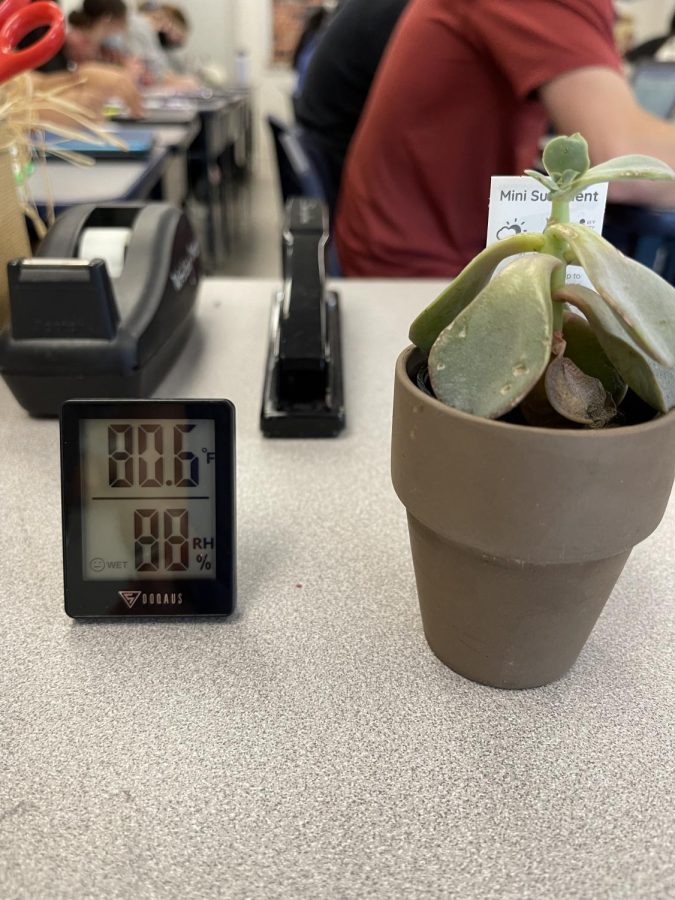Heating Up: Tensions Rise as the HVAC System Continues to Increase Building Temperature
Media by Jessica Brown
Jessica Brown, language arts teacher, captured the temperature of her room which was 12.6 degrees hotter than an average room temperature. “Once you have 28-30 bodies in this room, the temperature rises significantly,” Brown said. “Your focus is more on how uncomfortable you are rather than what’s happening in class.”
As a result of the construction that took place over the summer, the heating, ventilation and air conditioning (HVAC) units in certain areas of the building have been malfunctioning, causing many classrooms to be overheated.
Owen Alexander, sophomore, has experienced overheating in his 10th grade Accelerated Language Arts class.
“I just feel like my output of work in that class has decreased a lot since it’s been so hot,” Alexander said. “It still manages to be uncomfortably hot on the cool days.”
His window seat in the sun only adds to that heat, and he said moving classrooms is not an effective change.
“I wouldn’t even call it a solution,” Alexander said. “That would definitely be better for learning, but it seems like it doesn’t solve the problem because it’s just gonna force another classroom into the poor learning environment.”
Alexander’s language arts teacher, Jessica Brown, said she agrees moving rooms is a temporary solution to what seemed to be a long-term problem.
“If somebody is willing to give me their room for an hour, that’s really great,” Brown said. “But with no end in sight, if I do that consistently, I’m displacing them from their room every single day for the foreseeable future, which just doesn’t seem fair or right when I have what should be a viable classroom.”
Though she has tried moving to other classrooms, the Commons and even outside, Brown said getting her students to focus in these different learning environments has been a challenge.
“We go down to the Commons, and people think it’s suddenly a free-for-all, or we go outside and they’d rather sunbathe than read,” Brown said. “I can’t say I blame them. I feel like we’ve tried and tried and tried, but after a month and a half, I’m fighting a losing battle here.”
Fans have been purchased by the district and provided to teachers, though Brown said they are not making a difference as they only cool down those who they are directly facing.
“That makes it even more difficult to teach because there’s a mask and two fans going that I still have to talk over, so typically then I have to turn the fans off so that I can hear students and students can hear me,” Brown said.
The unit serving rooms 148-169, as well as classrooms 243, 245, 246, 247, 248, 253, 254 and 260, had a leak in the refrigerant condenser coil. In addition, the unit serving the third floor C-Wing had a supply motor that failed, according to an email sent to staff members from maintenance and grounds coordinator Bill Branson.
Though the unit ran at 50 percent capacity for most of the school year, it was replaced on Thursday, Oct. 14, and classrooms have significantly cooled down since then.
Jordan Shelton, language arts teacher, has seen a significant drop in the temperature of her room as well as a shift in the atmosphere of her students.
“Whenever students are sitting in a classroom and are starting to feel really hot and sweaty, they start to get on each others’ nerves a lot more,” Shelton said. “Confrontations and just frustrated exchanges between students, that I’m not seeing quite as often.”
Shelton said she is appreciative of the work that went into fixing the unit, and will not be taking air conditioning for granted ever again.
However, classrooms are not the only areas being affected. The unit surrounding the Library had a supply variable frequency fail, and though no definite arrival date has been set, a new one has been ordered and temporary modifications have been made.
The gym building also had a supply fan VFD failure, and student athletes such as Maya Esparza, senior volleyball player, have felt the effects. Esparza was injured in her game on Friday, Oct. 8, as a result of a slippery floor, coated in sweat.
“If it was a little colder I feel like this wouldn’t have happened,” Esparza said.
The heat in the gym often causes delays as the floor has to be wiped up to avoid safety hazards. Esparza said playing in such conditions drains the team as it takes their focus away from the game.
“I honestly don’t know why it hasn’t been fixed yet,” Esparza said. “I get hot classrooms, but I feel like the gym is becoming dangerous.”
Senior Principal Carl Hudson oversees facilities at MHS and said he recognizes the extent of the problem in other areas of the building and is working to have it fixed, but is happy that they have been able to resolve the problem in primary areas of the building.
“Thus far, everything has been good,” Hudson said. “It has been comfortable in the rooms.”
Though the lack of air circulation did have the potential to provide a breeding ground for the COVID-19 virus, Hudson said was never worried as the air in the building circulates at 11 times per hour and even more in large spaces like the Commons which is nearly double the recommended amount.
Your donation will support the student journalists of Marquette High School. Your contribution will allow us to purchase equipment and cover our annual website hosting costs. You may become a PATRON by making a donation at one of these levels: White/$30, Green/$50, Blue/$100. Patron names will be published in the print newsmagazine, on the website and once per quarter on our social media accounts.







